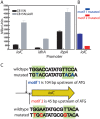Genetic and computational identification of a conserved bacterial metabolic module
- PMID: 19096521
- PMCID: PMC2597717
- DOI: 10.1371/journal.pgen.1000310
Genetic and computational identification of a conserved bacterial metabolic module
Abstract
We have experimentally and computationally defined a set of genes that form a conserved metabolic module in the alpha-proteobacterium Caulobacter crescentus and used this module to illustrate a schema for the propagation of pathway-level annotation across bacterial genera. Applying comprehensive forward and reverse genetic methods and genome-wide transcriptional analysis, we (1) confirmed the presence of genes involved in catabolism of the abundant environmental sugar myo-inositol, (2) defined an operon encoding an ABC-family myo-inositol transmembrane transporter, and (3) identified a novel myo-inositol regulator protein and cis-acting regulatory motif that control expression of genes in this metabolic module. Despite being encoded from non-contiguous loci on the C. crescentus chromosome, these myo-inositol catabolic enzymes and transporter proteins form a tightly linked functional group in a computationally inferred network of protein associations. Primary sequence comparison was not sufficient to confidently extend annotation of all components of this novel metabolic module to related bacterial genera. Consequently, we implemented the Graemlin multiple-network alignment algorithm to generate cross-species predictions of genes involved in myo-inositol transport and catabolism in other alpha-proteobacteria. Although the chromosomal organization of genes in this functional module varied between species, the upstream regions of genes in this aligned network were enriched for the same palindromic cis-regulatory motif identified experimentally in C. crescentus. Transposon disruption of the operon encoding the computationally predicted ABC myo-inositol transporter of Sinorhizobium meliloti abolished growth on myo-inositol as the sole carbon source, confirming our cross-genera functional prediction. Thus, we have defined regulatory, transport, and catabolic genes and a cis-acting regulatory sequence that form a conserved module required for myo-inositol metabolism in select alpha-proteobacteria. Moreover, this study describes a forward validation of gene-network alignment, and illustrates a strategy for reliably transferring pathway-level annotation across bacterial species.
Conflict of interest statement
The authors have declared that no competing interests exist.
Figures







References
-
- Majumder A, Chatterjee A, Dastidar K, Majee M. Diversification and evolution of L-myo-inositol 1-phosphate synthase. FEBS Letters. 2003;553:3–10. - PubMed
-
- Galbraith M, Feng S-F, Borneman J, Triplett E, Bruijn F, et al. A functional myo-inositol catabolism pathway is essential for rhizopine utilization by Sinorhizobium meliloti. Microbiology. 1998;144:2915–2924. - PubMed
-
- Roberts MF. Inositol in bacteria and archaea. In: Majumder AL, Biswas BB, editors. Biology of Inositols and Phosphoinositides. New York: Springer US; 2006.
-
- Berman T, Magasanik B. The pathway of myo-inositol degradation in Aerobacter aerogenes - dehydrogenation and dehydration. J Biol Chem. 1965;241:800–806. - PubMed
Publication types
MeSH terms
Substances
Associated data
- Actions
Grants and funding
LinkOut - more resources
Full Text Sources
Molecular Biology Databases

